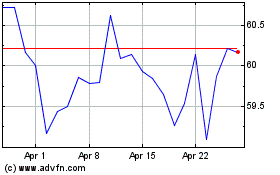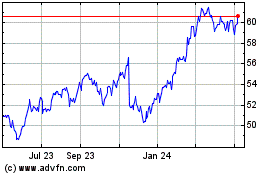Lower Prices at Wal-Mart: Good for Shoppers, Bad for Grocers
April 20 2017 - 8:29AM
Dow Jones News
By Heather Haddon and Sarah Nassauer
Wal-Mart Stores Inc.'s fight to defend its low-cost reputation
is helping to extend the longest food-price decline in decades.
The world's biggest retailer is investing heavily to lower
prices in its U.S. stores, the company's executives say, as
competition heats up against Amazon.com Inc. and European deep
discounters Aldi and Lidl. Wal-Mart is spending to beat
competitors' prices and test strategic price drops, mostly on food
and household goods sold at Wal-Mart stores in the Southeast and
the Midwest, say people familiar with the tactics.
Wolfe Research recently found prices for a basket of grocery
items at Philadelphia area Wal-Mart stores were 5.8% lower than a
year ago, while those in the Atlanta and Southern California
markets were 4.9% and 2.7% cheaper, respectively.
The price war, coupled with Wal-Mart's renewed focus on
refurbishing stores, is hurting the nation's biggest grocers.
Operating profits for U.S. supermarkets declined about 5% last
year, Moody's Investors Service said.
Kroger Co., the biggest U.S. supermarket chain, recently
reported its first quarterly decrease in same-store sales in 13
years. Cincinnati-based Kroger's shares fell 3% in February after
Wolfe Research reported that Wal-Mart was cutting prices in the
Midwest. The stock later recovered, but remains down 13% this
year.
Kroger Chief Financial Officer Mike Schlotman recently said
pressure from Wal-Mart, which sells more food in the U.S. than any
grocer, was mounting. "We certainly have seen them do things better
than they historically have," he said.
To keep up, Kroger says it has spent more than $3.7 billion to
lower prices over the last decade. Kroger gave voluntary buyouts to
roughly 1,300 workers, and is reducing planned capital investments
by around a fifth this year.
Target Corp., where executives are trying to turn around a
struggling grocery business, is also investing $400 million in
online sales and lower prices. It is also simplifying its messaging
to emphasize consistently low prices instead of complicated
short-term deals, a spokeswoman said.
"We know we have to be competitively priced every day on those
core essentials," Target Chief Executive Brian Cornell told
investors recently.
Retailers are offering more discounts as food prices continue to
fall. Year-to-year food retail prices declined for the 16th month
in March, the longest stretch since 1956. But some believe the
trend will reverse this year as commodity prices climb out of a
multiyear rout. Moody's expects prices for food consumed at home to
rise 1% in 2017.
Wal-Mart, based in Bentonville, Ark., has been fighting its
competitors on price since its founding in 1962. But it backed off
in recent years at the same time that customers started using
mobile phones in stores to compare prices on Amazon and discounters
rapidly added stores.
Fighting back, Wal-Mart executives in 2015 said they would
invest heavily to lower prices over three years. In a presentation
to suppliers in February, Megan Crozier, Wal-Mart's senior vice
president of packaged goods, said Wal-Mart wants its prices to be
15% lower than its competitors' 80% of the time, according to
attendees.
"It's why we exist," she said, according to one of these
people.
Wal-Mart's price cuts are eating into its own profit, forcing it
to cut costs and putting pressure on its vendors. But the company
is stealing market share. While profit fell 18% in the most recent
quarter, Wal-Mart's sales in existing stores, a key metric of
retailer health, have risen for 10 consecutive quarters.
The fight between big food retailers is good for consumers. Last
year, shoppers paid 1.3% less than a year earlier for eggs, meat
and other staples, federal data shows, the steepest drop since
1959. Two thirds of consumers surveyed recently by the Food
Marketing Association said they chose where to buy groceries based
on price.
"You have to be a smart shopper," said Lisa Ortega, a
40-year-old mother of a one-year-old in Chicago who often shops at
Costco. "I'm not in a position where I can't care."
Write to Heather Haddon at heather.haddon@wsj.com and Sarah
Nassauer at sarah.nassauer@wsj.com
(END) Dow Jones Newswires
April 20, 2017 08:14 ET (12:14 GMT)
Copyright (c) 2017 Dow Jones & Company, Inc.
Walmart (NYSE:WMT)
Historical Stock Chart
From Mar 2024 to Apr 2024

Walmart (NYSE:WMT)
Historical Stock Chart
From Apr 2023 to Apr 2024
